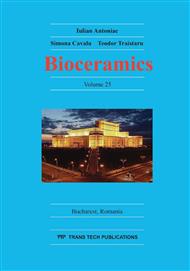p.391
p.397
p.404
p.412
p.416
p.422
p.427
p.431
p.436
Biomechanics of Vertebroplasty: Effect of Cement Viscosity on Mechanical Behaviour
Abstract:
Vertebroplasty is a minimally invasive surgical procedure, which requires efficacious percutaneous cement delivery via a cannulated needle to restore the strength and stiffness in osteoporotic vertebral bodies. Cement viscosity is understood to influence the injectability, cohesion and cement retention within the vertebral body. Altering the liquid to powder ratio modifies the viscosity of bone cement; however, the cement viscosity-response association between cement fill and augmentation of strength and stiffness is unknown. The aim of this study was to determine the relationship between viscosity, cement fill and the potential augmentation of strength and stiffness in an open pore foam structure that was representative of osteoporotic cancellous bone using an in vitro prophylactic vertebroplasty model. The results showed a strong linear correlation between compressive strength and stiffness augmentation with percentage cement fill, the extent of which was strongly dependent on the cement viscosity. Significant forces were required to ensure maximum delivery of the high viscosity cement using a proprietary screw-driven cement delivery technology. These forces could potentially exceed the normal human physical limit. Similar trends were observed when comparing the results from this study and previously reported cadaveric and animal based in vitro models.
Info:
Periodical:
Pages:
416-421
Citation:
Online since:
November 2013
Authors:
Price:
Сopyright:
© 2014 Trans Tech Publications Ltd. All Rights Reserved
Share:
Citation:


